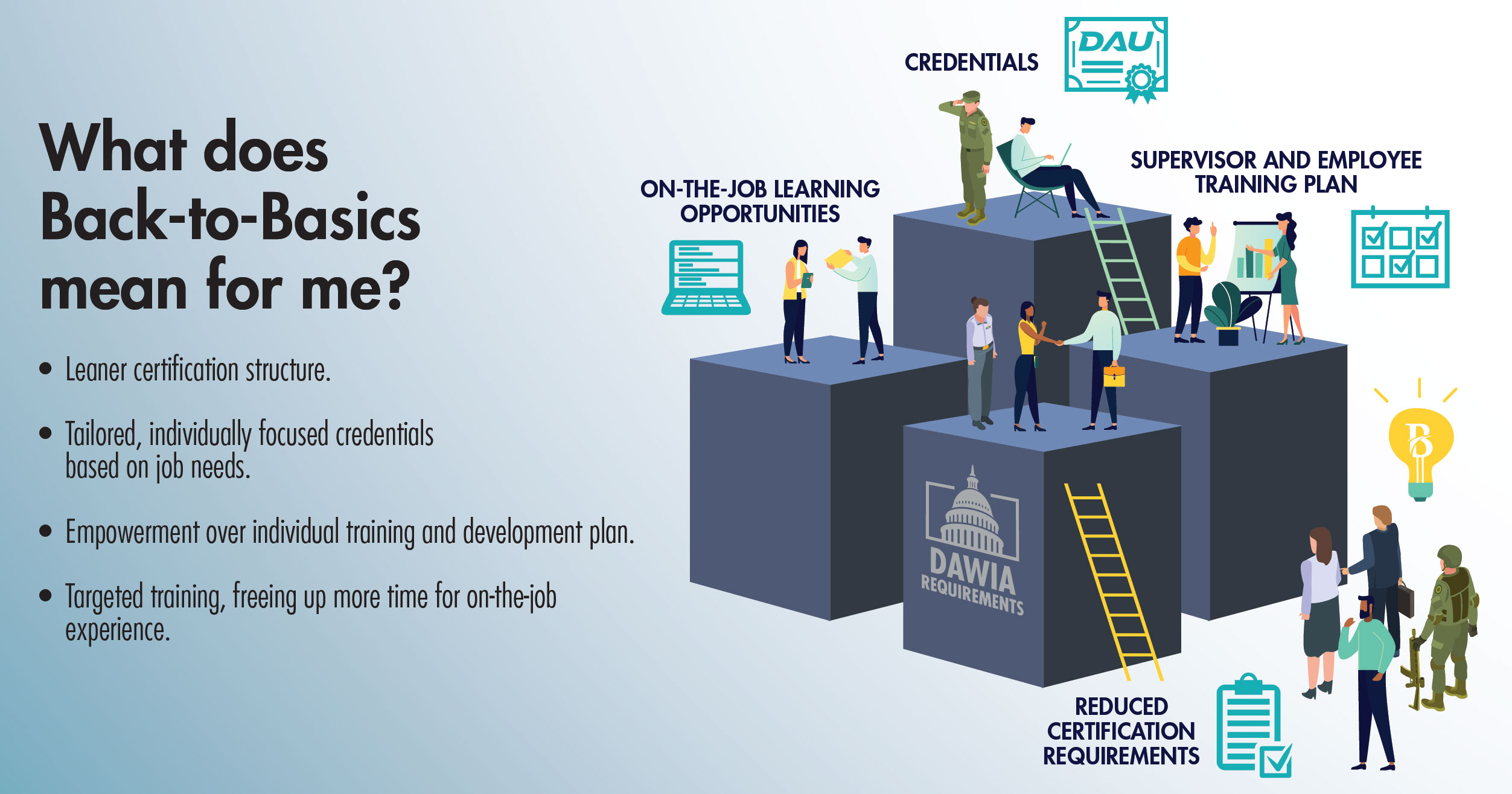
OPENING REMARKS: The Hon. Ellen Lord, former undersecretary of defense for acquisition and sustainment, office of the secretary of defense public affairs, records opening remarks for the TEDxDAU virtual event September 8, 2020, in the Pentagon Briefing Room. The event was designed to inspire the workforce through a sharing of ideas and best practices to accelerate innovation across the federal government, DOD, industry and academia. (DOD photo by Marvin Lynchard)
Career Navigator
Back-to-Basics puts the power of training in the hands of the employee.
by Jacqueline M. Hames
Change is coming.
Since September of 2020, when the Hon. Ellen M. Lord, former undersecretary of defense for acquisition and sustainment, issued the memorandum “ ‘Back-to-Basics’ for the Defense Acquisition Workforce,” we’ve been hearing about the Back-to-Basics program. Its goal is to create streamlined training requirements and increased opportunity for workforce members to receive targeted career development and job-relevant training when they need it. In other words, Back-to-Basics will create a modern continuous learning environment and empower employees to craft their careers.
The program’s mission is “to undertake the first major overhaul of the Defense Acquisition Workforce Improvement Act since its inception and re-scope the definition of the coded acquisition workforce,” said Scott Greene, strategy and communications division chief in the Director of Acquisition Career Management (DACM) Office. The program takes a hard look at acquisition positions across the Office of the Secretary of Defense (OSD) and streamlines the 14 career fields into six functional areas: Business Financial Management/Cost Estimating, Contracting, Engineering and Technical Management, Life Cycle Logistics, Program Management, and Test and Evaluation. Back-to-Basics implementation is expected February 15, 2022.

THE BASICS: The Back-to-Basics certification and training framework provides the workforce with hands-on experience to acquire, develop and sustain long term targeted career goals.
Rob Richardson Jr, the Army’s director for acquisition career management, said that the program is focusing more on experiential training, “which is the piece that I think has always been missing. Folks have the certification, but really no experience.” In the past, employees could be Level III certified and never have been in a program office. “I’m not sure how you learn to manage without being there, going through the process and getting those bumps and bruises along the way, which are important to develop as an Army Acquisition Workforce professional,” he said.
“In essence, [Back-to-Basics is] reducing the amount of training, but in a good way,” Greene said. It’s reducing [required training] to make it more focused on what individuals need at the fundamental requirement level and then adding… credentialing.” Defense Acquisition University’s (DAU) website for Back-to-Basics notes that the difference between certifications and credentials is that “certifications address statutory education, training, and experience requirements. Credentials address assignment specific, job-relevant needs.” Defense Acquisition Credentials are highly-focused blocks of training that require students to demonstrate mastery of the topic in order to pass. They are separate from and not required for functional area certifications—they are driven by the type of work being done and the needs of the employee, and they are recommended additions for individual development plans. Both the supervisor and the employee can add credentials to an employee’s individual development plan.
Streamlined training does away with “scrap learning,” Greene explained. It eliminates extraneous courses that not everyone in a functional area may need. “A lot of that scrap learning has become credentials, where you would take it if you need it,” he said.

PROFESSIONAL OFFERINGS: Back-to-Basics seeks to empower the workforce through training flexibility.
Back-to-Basics will give employees the power to choose the credentials they need to fit their jobs, Greene said, and it is the responsibility of the employee—and their supervisor—to keep up with the required courses for the employee’s functional area, as well as any extra credentials. “This is a big paradigm shift,” he said. “It’s going to be a challenge but also a benefit. The workforce—supervisors and employees—have been used to very prescriptive [training].”
According to Aaron Hutson, strategy and policy branch chief, currently the culture for acquisition training is to complete all certifications as soon as possible—sometimes even up to Level III certifications—but the DACM and DAU have learned through student feedback that the training was too front-loaded in this model. The Back-to-Basics program is moving toward a “train, apply, train, apply” model, where the learner is given more flexibility. “It empowers the learner to work with their supervisor…to determine the specialty training credentials that are needed,” he said.
“This framework will give some time back to the organization and the employee,” Hutson said. “There’s a reduction in prescriptive training across all functional areas and levels, some more than others, but that’s required training that’s been given back to the employee, local organization and supervisor.” That extra time can be used for on-the-job training and credentialing. While workforce members have always been able to cross-train over different functional areas, this “time back” will enable them to do it more readily than in the past, Greene explained.
DAU is complementing the Back-to-Basics goal of streamlining training by changing its curriculum, Hutson said. According to DAU, its transformation will include high-quality content that is more relevant to the learners’ needs, shorter courses, more variety in course offerings, more online courses, more learning resources available at the moment of need and, of course, credentialing. And in an interesting twist of events, COVID-19 restrictions have helped get this new training culture started. “COVID allowed DAU, I think somewhat unintentionally, but DAU capitalized on it to refine and improve their online learning platform,” Greene said.
“They are positioned very well to have a reduction in…in-person training. They are still going to have some of that, but bottom line, we’re going to see a lot more of what they are calling VILT—virtual instructor-led training,” he added.
Of course, the implementation of Back-to-Basics is not going to be a “one and done” situation, Richardson cautioned. It will be rolled out in phases so adjustments can be made to the program as necessary, to better serve the workforce.
Ultimately, individuals will have the freedom and responsibility to keep up with their required trainings and any additional training they want to have—something that is completely within the spirit of a continuous learning environment, Greene said.
“At the end of the day, this will be a much better process, much less time away from the job doing unproductive training,” Richardson said. “[It will] provide more opportunities that are productive, like going to [Naval Postgraduate School] or leveraging some of the DACM programs to improve your capabilities.”
“Change is hard,” he added. “Pack your patience. Expect some growing pains. We will get through it.”
For more information on Back-to-Basics, go to: https://go.usa.gov/xeaVp. Burning questions? Check out the frequently asked questions at: https://asc.army.mil/web/topics/btb/.
“Editor’s note: This article has been updated to reflect a change in the Back-to-Basics implementation date.”
JACQUELINE M. HAMES is an editor with Army AL&T magazine. She holds a B.A. in creative writing from Christopher Newport University. She has more than 10 years of experience writing and editing news and feature articles for publication.







